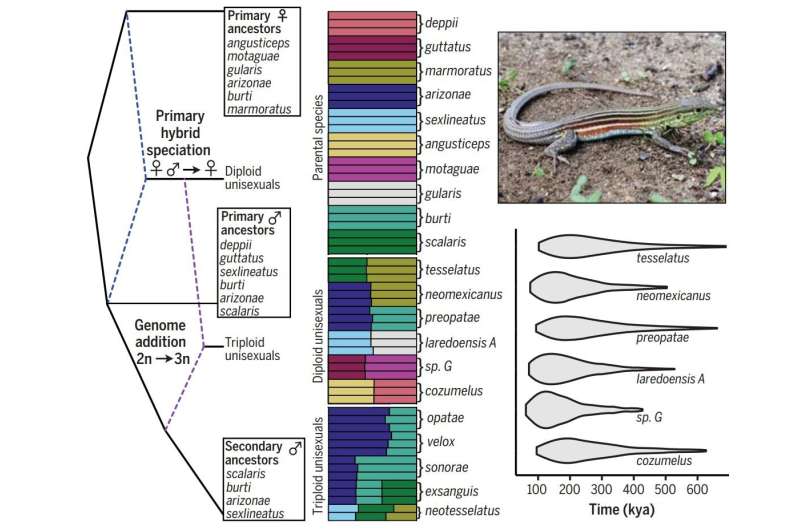August 12, 2022 report
Evolutionary network of whiptail lizards reveals predictable outcomes of hybridization

A quartet of researchers, two from the U.S. and two from Mexico, found evidence that suggests divergence time between ancestral parents can be used to predict the effects of hybridization—at least in lizards. In their paper published in the journal Science, the group describes their phylogenetic network study of whiptail lizards.
Prior research has shown that despite being unisex creatures (they are all female), whiptail lizards still have genetic diversity. The researchers with this new effort noted that this is not the case with other unisex creatures—most just make clones of themselves. Prior research has also shown that hybridization in a species arises due to a variety of factors, such as random behavioral changes that lead to more offspring, or simply as a means to increase genetic diversity, which has been shown to reduce birth defects. Hybridization can lead to both genetic diversity and/or the development of a new species.
To learn more about the whiptail lizard and its unique reproductive habits, the researchers used a phylogenetic network as a means of tracing its ancestry. Creating it involved tracing back the history of the lizard species and allowed the researchers to see where genetic divergence led to a unisex lineage. The researchers observed that a certain amount of time is required before divergence in a species can lead to the development of a unisex creature such as the whiptail lizard. Put another way, they suggest a certain degree of genetic distance between parental genomes must exist before a change as drastic as the evolution of a unisex lizard can develop. In the case of the whiptail lizard, the researchers calculated that time span to be approximately 10 million years.
The researchers suggest their work can be used to support a model that describes the process of divergence and the changes that occur in a species as it continues to evolve. And such a model could be used to explain why, or even how, hybridization can lead to such diverse outcomes—from increases in genetic diversity to the development of a new species. They also suggest the model could be used to predict the evolutionary outcome of certain creatures.
More information: Anthony J. Barley et al, The evolutionary network of whiptail lizards reveals predictable outcomes of hybridization, Science (2022). DOI: 10.1126/science.abn1593
Journal information: Science
© 2022 Science X Network





















